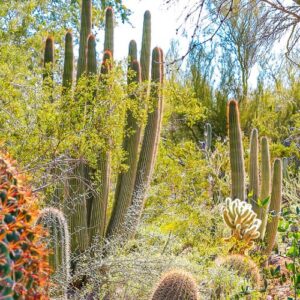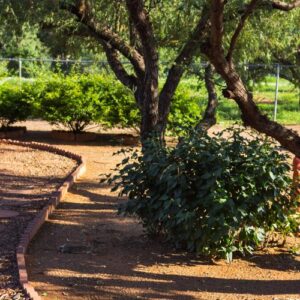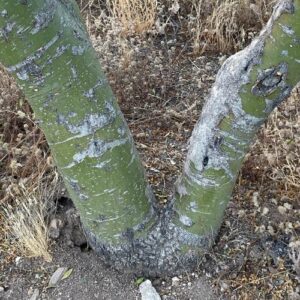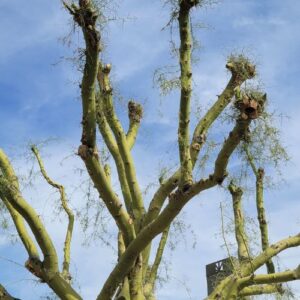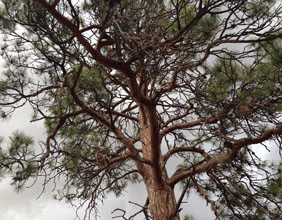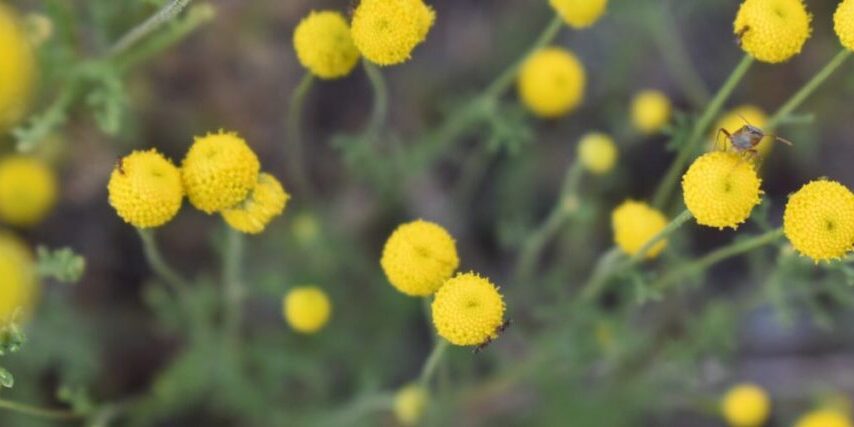
Did you know that Arizona’s wildfires are getting worse due to invasive weeds? Much of the focus has been on buffelgrass, but now a new weed has also begun taking over Arizona, known as invasive stinknet or globe chamomile.
Native to South Africa, this yellow ball-shaped plant may look harmless, but it’s causing issues in the Phoenix area and across Arizona at large.
In this article, we’ll show you how to recognize stinknet, what to do if you spot it, some problems that it is causing, and more.
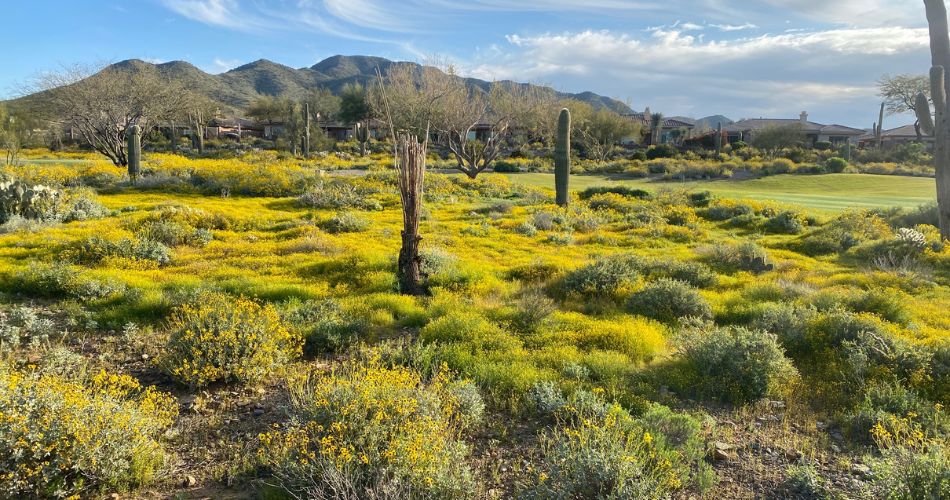
Image of stinknet in Anthem courtesy of Barry Allen, Certified Master Gardener, Maricopa County Extension
Stinknet is Causing Issues
Stinknet (Oncosiphon piluliferum or Oncosiphon pilulifer) may look like a fun, globe-shaped yellow flower, but this invasive noxious weed is causing many issues throughout Arizona and California.
When stinknet dries out, it becomes a fuel source for wildfires, helping to spread wildfires across our desert areas. Known as a “low-level ladder fuel,” dried stinknet can catch fire and spread the fire to shrubs or trees. It easily catches on fire and was one of the main reasons for some wildfires in Arizona in 2020.
The plant can cause respiratory allergies or dermatitis in some individuals. Amongst those with asthma, walking through a field of stinknet can cause wheezing.
Stinknet is displacing our native plants, as its spread has become uncontrolled.
It has also been found in agricultural fields, harming the growth of crops. When it takes over fields that cattle and other animals use as a food source, the animals don’t eat the stinknet, so they have less to eat. People have noted that even goats, which are famous for eating almost anything, won’t touch stinknet.
Where Stinknet Can Be Found
If you drive along I-10, you’ll probably notice stinknet along the highway. It has become widespread in both Maricopa and Pinal County and is becoming more common in Pima County as well.
Like other invasive plants, stinknet can be found in vacant lots, along roadways, in desert areas around residential properties, or in most other places where the seeds land and sprout.
Stinknet has been spotted here in Anthem, but also in California in the Los Angeles and San Diego areas. In all places except for its native South Africa, it has become invasive.
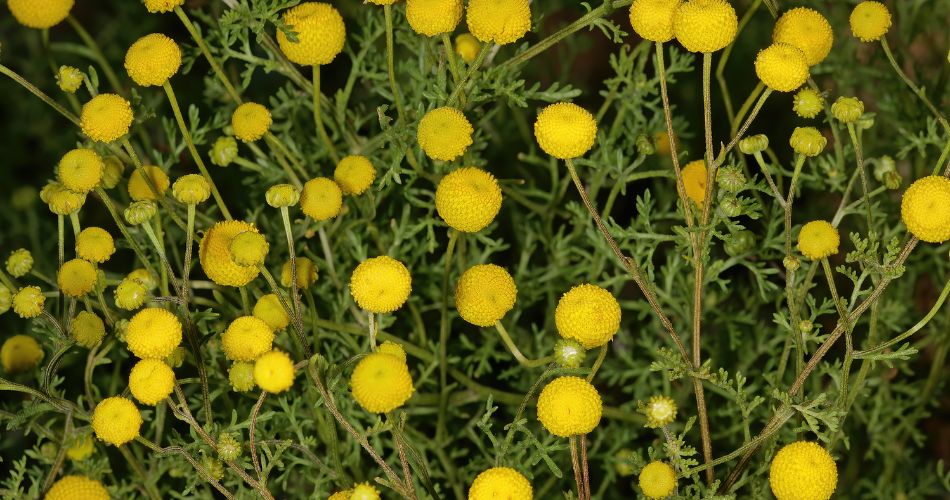
Invasive stinknet flowers. Image Courtesy of SA plants Own work, CC BY-SA 4.0.
How to Recognize Stinknet
Part of the sunflower family, stinknet is closely related to chamomile. In fact, stinknet is also referred to as “globe chamomile.” The globe part of the name refers to the yellow spheres that make up most of the flower head, consisting of small yellow flowers that will eventually form seeds.
Though it is related to chamomile, it is not the same plant, so we do not recommend using this noxious weed as a replacement for chamomile (in tea, for example). Globe chamomile is NOT recommended for consumption. Remember, even goats won’t eat this plant!
One of the easiest ways to distinguish stinknet from Arizona wildflowers is by its unique scent. Most people do not find the aroma pleasant, hence the name “stinknet.” For some, the fragrance is so overwhelming that it can cause headaches.
Stinknet will look different depending on what time of year you spot it.
This plant will germinate in late October or November, and abundant winter rains can make stinknet more plentiful.
Look for green leaves with scattered hairs in late winter or early spring. If you crush the leaves, they can release a pungent smell that has been compared to turpentine. The leaves look similar to the leaves on carrots.
Two months later, small flower heads will emerge, and in another month, the first flowers will begin to open. The flowers will appear at the base of the round section of the plant and move upwards.
By April and May, seeds will form on the flower head (each tiny flower on the flowerhead can produce one seed). The plant dries out and turns into a tan color, and the seeds are dispersed by the wind, animals, water, and traffic.
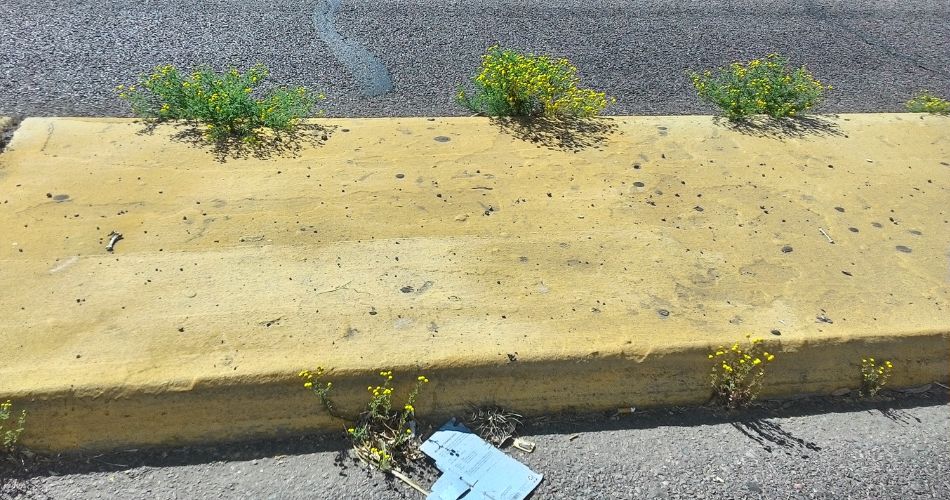
Invasive stinknet grows on a traffic median in a Phoenix road. Image courtesy of MB – Own work, CC BY-SA 4.0.
How to Help Control the Spread of Stinknet
Though stinknet is spreading rapidly across Arizona, you can help stop it!
Remove Stinknet If You Spot It
If you spot stinknet on your property, remove it. Stinknet can be pulled up from the ground. If you pull it when the ground is loose or wet from recent rains, you should be able to pull up the roots as well. Since this plant can resprout from the roots, try to get all of them when you pull it from the ground.
Remember to wear gloves as stinknet can cause contact dermatitis thanks to the oil it produces. It can also cause allergies and asthma, so use caution! Place any pulled plants directly into the trash to avoid the seeds being spread.
Stinknet can also be cut down but will regrow from the roots, so you’ll have to continually cut it back.
Most importantly, try to remove stinknet before it releases its seeds. The earlier you remove it, the better, as sometimes removing dried stinknet can release the seeds.
Consider Pre-Emergent Weed Control
Some pre-emergent applications, when applied at the correct time, may prevent stinknet from germinating. Contact Titan Pest for more information about our pre-emergent options.
Learn more about pre-emergent weed control >>
Learn How to Recognize Stinknet
Stinknet hasn’t been in Arizona long, but there are already many resources to help you identify this invasive plant.
Check out:
- Stinknet Invasive Weed! Handout from the University of Arizona Cooperative Extension (PDF)
- Stinknet: A Weed Advancing in Southern Arizona from the University of Arizona Cooperative Extension (PDF)
- Invasive Species Alert – Stinknet! From the Arizona Native Plant Society. They also have brochures on stinknet available in English and Spanish.
- This slideshow has lots of information as well as specific places where you can find stinknet in the Phoenix and Tucson areas. https://www.swvma.org/wp-content/uploads/Stinknet-Presentation-from-SWVMA-Meeting-20190421.pdf
Alert Others to Stinknet’s Presence
Report sightings of stinknet to iNaturalist. This can help determine the plant’s spread, let ordinances know places where it needs to be removed and more.
Let Others Know About Stinknet
Now that you are familiar with this plant, how invasive it is, and the problems it can pose, be sure to let others know! Stinknet is tricky because it looks like a beautifully unique wildflower, but looks can be deceiving!
Contact Titan Tree Care
Whether you need assistance in identifying trees, plants, or invasive weeds on your property, want to ensure your trees are healthy, or want to schedule pre-emergent weed control services, contact Titan Tree.
We can help keep your property healthy, weed-free, and beautiful!
See Our Latest Articles
More Articles Like This

Titan Tree Care is a full-service tree care company located in Anthem, AZ and serving all of North Phoenix. We offer a wide range of services to meet your tree care needs, including tree and palm trimming, tree pruning, tree removal, stump grinding, and more. We also offer insect or disease treatments and fertilization services. We are dedicated to providing high-quality, safe, and effective tree care services to our customers and work hard to ensure that your trees are healthy and look their best.



